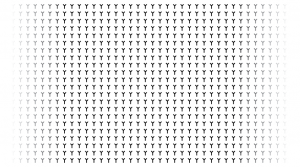One question tends to reoccur: How many antennas can a Massive MIMO base station usefully deploy? Current thinking for macro-cellular is that 100-200 antennas would be suitable. Will we in the future see a lot more, thousands or so?
In that application, I don’t think so. Here is why.
What ultimately limits Massive MIMO is mobility: no more than half of the coherence time-bandwidth product should be occupied by pilot transmission activities. (This is the “half and half rule”.) In macro-cellular at 3 GHz, with highway mobility we may have on the order of 200 kHz x 1 millisecond coherence; that is 200 samples. With pilot reuse of 3 (that practically does away with pilot contamination), we could, then ultimately learn the channel to some 30 simultaneously served terminals – assuming mutually orthogonal pilots. Once the number of base station antennas M reaches beyond twice this number, with some margin – say M=100, the spectral efficiency grows logarithmically with M. That means, even doubling M yields only a 3dB effective SINR increase, that is a single extra bit per second/Hz per terminal. Beyond M=100 or M=200, it may not be worth it. Multiple antennas are only truly useful if they are used to multiplex, and mobility limits the amount of multiplexing we can perform.
So why not quadruple the number of antennas for additional coverage? May not be worth it either. Going from M=200 to M=2000 gives 10 dB – that pays for a 75% range extension, or, alternatively, a tenth of the losses incurred by an energy-saving coated window glass.
In stationary environments, the story is different – a topic that we will be returning to.


An excellent post! It also brings an interesting question to my mind. In some massive MIMO channel modeling literature, one criticism of the assumption of planar wavefront impinging on the antenna array is that as the number of antenna elements gets too large, the planar wave-assumption is no longer practical, and spherical wave assumption is more realistic. However, with the given chain of argument, can we say that the assumption of planar wavefront, instead of the spherical wavefront, impinging on the massive MIMO array is still justified, at least to some extent?
Yes, agree, eventually any model assuming planar waves will be inaccurate. However, that should not really affect the main arguments made here. The important thing is that the channels are “sufficiently orthogonal” as to facilitate spatial multiplexing.
The Fraunhofer distance is a common approximation of how far you need to be from an array to observe planar waves (i.e., to be in the far-field). The Fraunhofer distance grows with the square of the size of the array, thus you need to be further away from a large array to be in the far-field.
However, as Erik says, whether or not the users are in the far-field does not affect the main arguments here. In fact, it could be a benefit to be in the near-field since two signals that come from the same angle can still be resolved based on how spherical the wavefronts are.
Thanks Dr. Bjornson. I completely agree with your point– even if two users uplink direction of arrival is same, with spherical wave assumption, we can still discriminate the users based on how far they are from the BS antenna array. However, I am just wondering– do you think it is feasible, in terms of tractability of any analytical work, to pursue parametric channel modeling with spherical wave assumption (for example, DoA steering vectors will no longer have simple vandermonde structure anymore)?
I don’t know how tractable such an analysis would be.
One of the beautiful things with the pilot-based channel estimation in Massive MIMO is that it doesn’t rely on any a priori assumptions or knowledge of channel characteristics. Parametric models might work well in theory, but in practice we need to design a system that can handle any type of user channel.
Thanks Dr. Larsson.
Thank you Dr. Bjornson.
Hi,
Thanks for the post. When you say “the coherence time- bandwidth production” do you mean the production of the coherence time and the coherence bandwidth or do you mean the production of the coherence time and the signal bandwidth?
When from a number of BS antennas (for example 200) the sum- rate does not increase much as we increase the number of BS antennas, then how does the sum-rate asymptotically tend to infinity? Is the increase rate slow?
For large numbers of antennas, M, the rate grows logarithmically in M.
To the other questions, I suggest the reading of Fundamentals of Massive MIMO
How many antenna elements are ideal (or required) at the UE in Massive MIMO scenario?
One antenna is sufficient, but the more antennas, the better.
It really depends on the frequency band. At sub 6 GHz frequencies, one dual-polarized antenna is enough. As you increase the carrier frequency, more antenna elements are needed to get the same physical aperture.